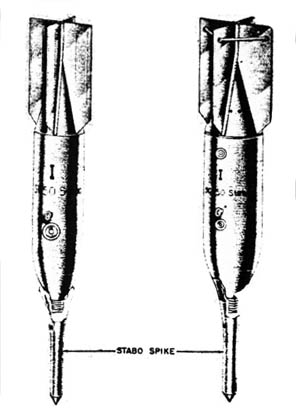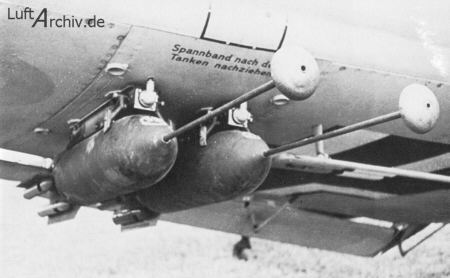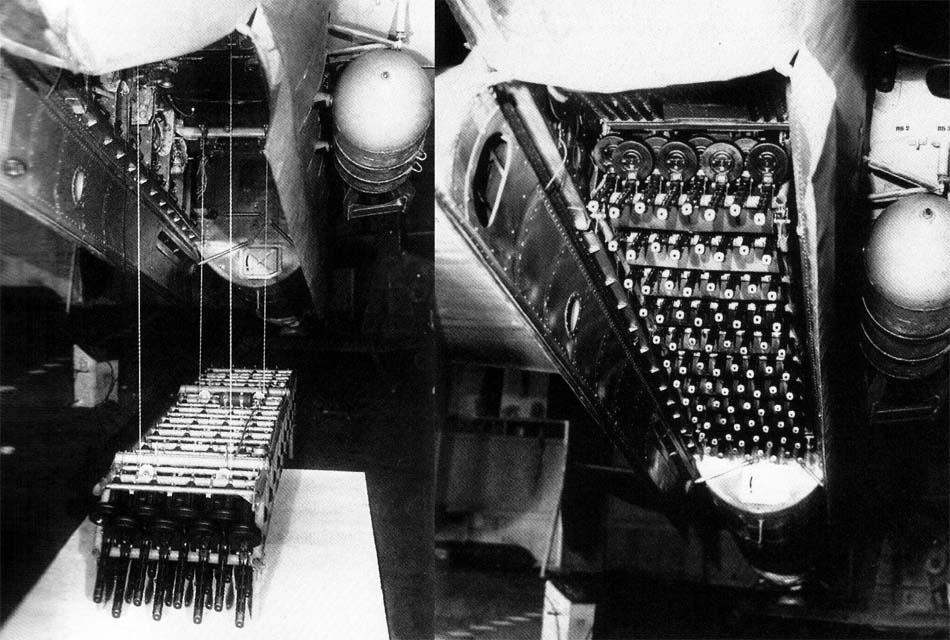alguem sabe identificar que raio de bomba alemã É esta ?

alguem sabe identificar que raio de bomba alemã É esta ?

Replies sorted oldest to newest

That is a Ju 87B armed with 4 SC50 (and one 250kg) bombs that have additional percussion detonators(IIRC called "Dienert stab") installed on the nose. Idea of these was to detonate the bombs half a meter from the ground thus giving them better shrapnel coverage.
Stachelbombe (spike bomb)
This attachable device for smaller bombs (SD 50/70/250) was used to prevent the bomb from bouncing of a target, sticking it into the ground. The bomb then was detonated by a delaying fuse or a "disturbance fuse", for when attacking railways, so the vibrations from the passing train would set off the charge.

Dinort-Stäbe (Dinort rods)
Named after Oskar Dinort, a Stuka pilot, these rods were, similar to the spikes, attachable to smaller bombs and would activate their fuse when the rod hit the ground. The rods being 37.5 or 60 cm long, the bomb would cause an air blast effect.
Also seen in this picture are the fin-mounted Jericho devices.

Essas bombas alemãs tem a mesma função dessa bombas modernas:

E ESTA

FALANDO EM COISAS ESTRANHAS

Era para detonar sem se enterrarem, fazendo efeito corta margarida!
Rodas provisórias:
E tem solução dos russos usando metralhdoras PPSH no bombay dos bombardeiros:


Será que um trem desses era eficiente??!!!
CACETE QUANDO PENSO QUE JÁ VI TUDO QUE É BIZARICE
NÃO TEM GRAÇA BRINCAR ASSIM

Será que um trem desses era eficiente??!!!
Parece que na hora de descarregar contra colunas de veículos alemães fazia um sucesso voando baixo, mas pode ver que havia bombas do lado externo, na raiz da asa.
Será que um trem desses era eficiente??!!!
Parece que na hora de descarregar contra colunas de veículos alemães fazia um sucesso voando baixo, mas pode ver que havia bombas do lado externo, na raiz da asa.
Também reparei nas bombas. Mas será que não tinha que voar muito baixo para que fosse efetivo e assim ficar exposto ao fogo anti aéreo.
Será que um trem desses era eficiente??!!!
Não creio, a saraivada de tiros era violento só contra infantes em espaço aberto, mas durava pouco tempo já que cada metraca levava "só" um tambor. Agora imagine ter de re-municiar tudo isso a cada missão do esquadrão ? Se tivesse sido bem sucedido veríamos vários casos.
Nos EUA testaram algo com Thompsons no entre guerras:
The Thompson was mounted in 2 different aircraft configurations that I am aware of. The Auto-Ordnance 1923 Catalog shows 28 Thompsons mounted in a Larsen aircraft.
Wing mounted Thompsons were later placed on two different types of aircraft. Ron mentioned the "Jenny" style aircraft, and I believe he refers to the wing mounts. On page 49 of Tracie's book, there are 3 pictures of the double mounted Thompsons on the wing of a DH-4B. I have some of the same photos seen in the book, and the close-up of the wing mount is dated 7-7-26 on the back.
Switching back to the Larsen mounting of the 28 Thompson SMG's shown in the 1923 Auto-Ordnance catalog, an article by H.E. Hartney appeared in 2 different publications in November, 1921, further detailing this airborne Thompson setup. Here is what the article said in the November-December 1921 issue of Army Ordnance magazine:
The New Larsen All-Metal Attack Plane
Eminent naval strategists and tacticians admitted last summer after the bombing tests were over that they would be forced to give the airplane more consideration hereafter in all naval and war preparation. Already another phase of aviation warfare is before the public and may give the Army tactician just as rude a shock as it did the Navy, for it threatens to upset calculations and war plans on land radically. Attack aviation is that portion of military air forces that aims at ground troops and ground harassment generally. It developed during the last few months of the war, but owing to the limitations of production was used very little on either side. Ludendorff was one of its strongest advocates, but its possibilities were appreciated and an approximation thereto was attempted by our own American troops, particularly those of the first Pursuit Group. Those fliers who from low altitude bring fire to play on enemy forces either coincident with or irrespective of the infantry waves of attack, who act more or less independently of the ground troops for purposes purely offensive were classified during the last few days of the war as attack aviators and their work was deadly.
To be successful an attack plane must be armored, it must have great speed, it must be able to operate from a base far in the rear, it must have good climb, but, above all, it should have overwhelming power of fire. To deprive it of its armor would be certain destruction, for it must fly at extremely low altitude, not more than 400 feet; to rob it of speed or range of action would be a handicap and to take away its fire effectiveness by having only a few machine guns aboard would be to deprive it of its very function - fire power delivery. Pursuit planes of the World War would not suffice, much less would the makeshifts built up around old DH4's or Martin bombers. Something entirely new had to be brought out, and it appears that a private citizen, Mr. John M. Larsen, will be credited with the solution of a problem that for some time to the airman has seemed without solution. Certainly his product demonstrates beyond question that he is an aeronautical engineer with a keen insight into aerial tactics, for the whole layout seems calculated to fall in line with the acknowledged requirements of such a plane.
For the benefit of those readers who have not been fortunate enough to inspect this new machine it will suffice to state that this plane is all-metal in construction, is equipped with a Liberty 400-horsepower motor, has great range of action, speed and climb far beyond that of any machine its size existing on the front during the war, and the startling thing about it is that it has thirty Thompson Submachine Guns aboard and one man can operate them and control their fire with perfect ease.
Each Thompson Submachine Gun fires at a rate of 1,500 shots a minute or a fire rate of 45,000 shots a minute for the plane. These figures have never heretofore even been approached.
A few points about the preceding article...
- The 1500 RPM reference probably came from earlier Model of 1919 Thompsons, unless the Model of 1921's had some kind of special modification for aircraft use.
- The article references DH4 aircraft mountings attempted prior to the article, which were probably not Thompsons.
- The total of 30 Thompsons mentioned mounted to the Larsen is 2 more than what was shown in the 1923 Auto-Ordnance catalog. This could be an error, or perhaps 2 additional guns were mounted.
The Thompson aircraft mountings are of interest to me, so I thought I would post this additional material for others to see. Maybe others have more information that can be offered up on the subject.
Será que um trem desses era eficiente??!!!
Não creio, a saraivada de tiros era violento só contra infantes em espaço aberto, mas durava pouco tempo já que cada metraca levava "só" um tambor. Agora imagine ter de re-municiar tudo isso a cada missão do esquadrão ? Se tivesse sido bem sucedido veríamos vários casos.
Nos EUA testaram algo com Thompsons no entre guerras:
The Thompson was mounted in 2 different aircraft configurations that I am aware of. The Auto-Ordnance 1923 Catalog shows 28 Thompsons mounted in a Larsen aircraft.
Wing mounted Thompsons were later placed on two different types of aircraft. Ron mentioned the "Jenny" style aircraft, and I believe he refers to the wing mounts. On page 49 of Tracie's book, there are 3 pictures of the double mounted Thompsons on the wing of a DH-4B. I have some of the same photos seen in the book, and the close-up of the wing mount is dated 7-7-26 on the back.
Switching back to the Larsen mounting of the 28 Thompson SMG's shown in the 1923 Auto-Ordnance catalog, an article by H.E. Hartney appeared in 2 different publications in November, 1921, further detailing this airborne Thompson setup. Here is what the article said in the November-December 1921 issue of Army Ordnance magazine:
The New Larsen All-Metal Attack Plane
Eminent naval strategists and tacticians admitted last summer after the bombing tests were over that they would be forced to give the airplane more consideration hereafter in all naval and war preparation. Already another phase of aviation warfare is before the public and may give the Army tactician just as rude a shock as it did the Navy, for it threatens to upset calculations and war plans on land radically. Attack aviation is that portion of military air forces that aims at ground troops and ground harassment generally. It developed during the last few months of the war, but owing to the limitations of production was used very little on either side. Ludendorff was one of its strongest advocates, but its possibilities were appreciated and an approximation thereto was attempted by our own American troops, particularly those of the first Pursuit Group. Those fliers who from low altitude bring fire to play on enemy forces either coincident with or irrespective of the infantry waves of attack, who act more or less independently of the ground troops for purposes purely offensive were classified during the last few days of the war as attack aviators and their work was deadly.
To be successful an attack plane must be armored, it must have great speed, it must be able to operate from a base far in the rear, it must have good climb, but, above all, it should have overwhelming power of fire. To deprive it of its armor would be certain destruction, for it must fly at extremely low altitude, not more than 400 feet; to rob it of speed or range of action would be a handicap and to take away its fire effectiveness by having only a few machine guns aboard would be to deprive it of its very function - fire power delivery. Pursuit planes of the World War would not suffice, much less would the makeshifts built up around old DH4's or Martin bombers. Something entirely new had to be brought out, and it appears that a private citizen, Mr. John M. Larsen, will be credited with the solution of a problem that for some time to the airman has seemed without solution. Certainly his product demonstrates beyond question that he is an aeronautical engineer with a keen insight into aerial tactics, for the whole layout seems calculated to fall in line with the acknowledged requirements of such a plane.
For the benefit of those readers who have not been fortunate enough to inspect this new machine it will suffice to state that this plane is all-metal in construction, is equipped with a Liberty 400-horsepower motor, has great range of action, speed and climb far beyond that of any machine its size existing on the front during the war, and the startling thing about it is that it has thirty Thompson Submachine Guns aboard and one man can operate them and control their fire with perfect ease.
Each Thompson Submachine Gun fires at a rate of 1,500 shots a minute or a fire rate of 45,000 shots a minute for the plane. These figures have never heretofore even been approached.
A few points about the preceding article...
- The 1500 RPM reference probably came from earlier Model of 1919 Thompsons, unless the Model of 1921's had some kind of special modification for aircraft use.
- The article references DH4 aircraft mountings attempted prior to the article, which were probably not Thompsons.
- The total of 30 Thompsons mentioned mounted to the Larsen is 2 more than what was shown in the 1923 Auto-Ordnance catalog. This could be an error, or perhaps 2 additional guns were mounted.
The Thompson aircraft mountings are of interest to me, so I thought I would post this additional material for others to see. Maybe others have more information that can be offered up on the subject.
![]()
Será que um trem desses era eficiente??!!!
Parece que na hora de descarregar contra colunas de veículos alemães fazia um sucesso voando baixo, mas pode ver que havia bombas do lado externo, na raiz da asa.
Também reparei nas bombas. Mas será que não tinha que voar muito baixo para que fosse efetivo e assim ficar exposto ao fogo anti aéreo.
O tiro útil, ou seja enquanto foi disparada e começa a cair deve ser uns 100m, para baixo e em angulo, somada a velocidade da aeronave, poderiam disparar a mais de 100m de altitude e teriam um bom resultado, e remuniciar não deveria ser problema, era só trocar 88 carregadores, é claro que expunha a aeronave a flak, era o risco.